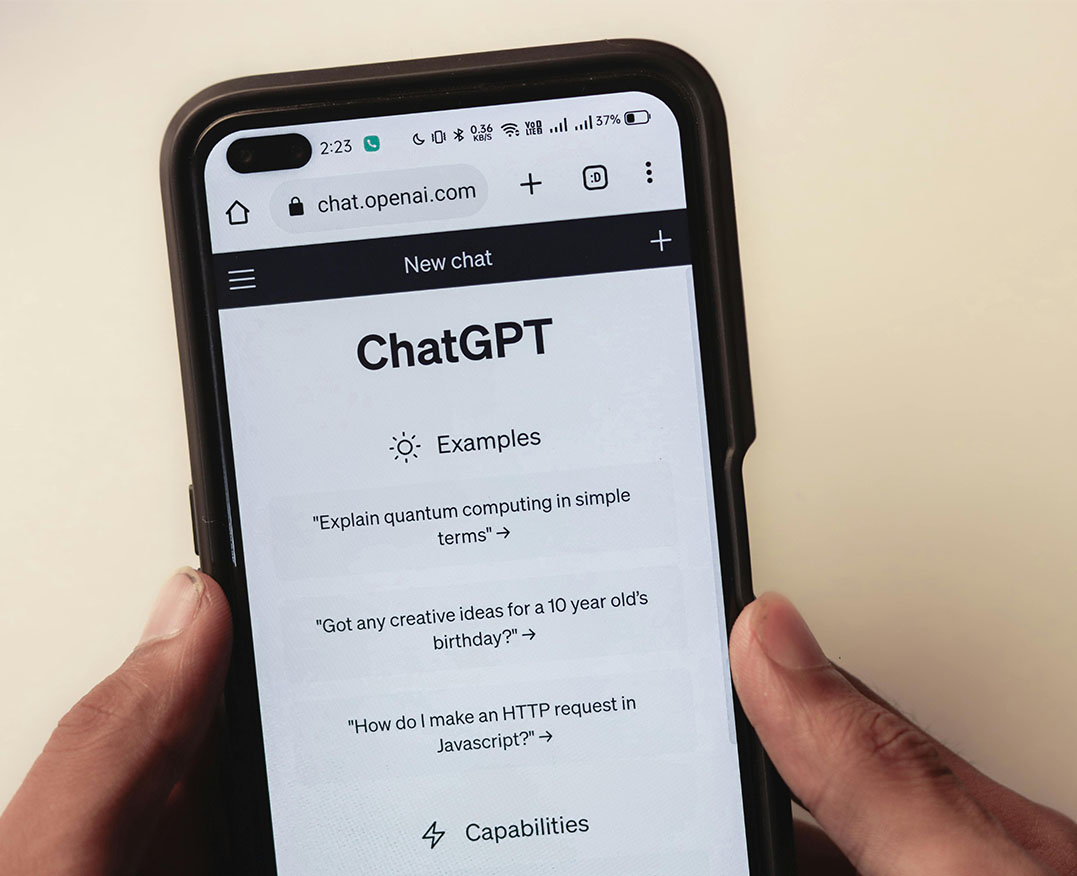Artificial intelligence (AI) is capable of achieving incredible things. But it really builds up a sweat while it does so.

Every time you prompt Midjourney or ChatGPT to generate an image, an explanation or an email, the host company’s servers run thousands of calculations to deliver the goods. This process uses vast amounts of energy. To keep the servers from overheating, water systems are often used to absorb the heat and carry it off to cooling towers to evaporate.
Using OpenAI’s ChatGPT-4 model to generate a 100-word email alone sweats off more than an Evian bottle’s worth of water (519 millilitres), according to a recent study by The Washington Post (WaPo) and the University of California. And prompting is also a massive drain on the national grid. According to WaPo, the electricity used to generate that 100-word email is equal to powering 14 LED light bulbs for an hour (0.14 kilowatt-hours (kWh)).
So, we know how much water and energy ChatGPT uses per prompt. But how much does it consume in total? The team here at Business Energy UK combined WaPo’s findings with available figures on the number of ChatGPT users to visualise how much energy and water the product uses every day, week, month and year.
ChatGPT Prompts Consumes Enough Electricity Daily to Power the Empire State Building for a Year and a Half
At a moment when America’s ageing power grid is already struggling, AI adds unprecedented demand for electricity. According to WaPo, “Northern Virginia needs the equivalent of several large nuclear power plants to serve all the new data centers planned and under construction.” Another study found that NVIDIA’s servers alone could burn through 85.4–134.0 terawatt hours (TWh) each year by 2027 — or three to five times the electricity consumption of Ireland.
Using WaPo’s figures, we calculated that ChatGPT may presently use around 39.98 Million kWh per day — enough to charge eight million phones. Each year, the 117 lowest-consumption countries each consume less electricity than ChatGPT.
Data servers use an incredible amount of energy to first train AI models and then process the ongoing demands of users. “Both phases are very energy-intensive, and we don’t really know what the energy ratio there is,” says data scientist Alex de Vries.“ Historically, with Google, the balance was 60 percent inference [generating responses], 40 percent training. But then, with ChatGPT, that kind of broke down—because training ChatGPT took comparatively very little energy consumption, compared with applying the model.
“[T]hese large language models that ChatGPT is powered by are notorious for using huge data sets and having billions of parameters. And of course, making these models larger is a factor that contributes to them just needing more power.”
ChatGPT Consumes Almost a Million Bathfuls of Water Every Day
Even before the AI boom, data centres were among America’s top ten industrial or commercial industries. Today, even a smaller data centre can sweat up to 18,000 gallons of water per day, while “hyperscale” data centres such as Google’s burn through up to 550,000 gallons per day.
Globally, ChatGPT uses around 39.16 million gallons daily, the equivalent of everyone in Taiwan flushing their toilet at once. Over a year, that’s enough to fill Central Park Reservoir seven times, as our comparative graphic below illustrates.
Click Here To Save Money On Energy 
The water AI companies use to cool their servers is the same fresh water used for drinking, cooking and washing — and to put out fires. In the U.S., around one in five data centers draw water from areas that are already over-stretched; critics were quick to blame AI’s thirst when hydrants ran dry during the LA fires in January.
Meanwhile, in the UK, Keir Starmer’s plans to increase AI capacity immediately came into conflict with existing environmental pressures, with the first AI growth zone planned for the UK’s highest water-risk area in Culham, Oxfordshire. According to the Guardian, England faces a shortfall of five billion litres of water daily by 2050, even without allowing for data centre growth.
Energising the Future
Water demand and supply may be a local dynamic, but it is a global issue. Just 0.5% of the earth’s water is available as fresh water; if the world’s water supply were 26 gallons, fresh water would make up just half a teaspoon.
Water-deprived countries already struggle to meet their data servers’ needs. But some American businesses see the developing world — where water supply can be the most strained — as a huge developing market for digital products, including AI. Others may use overseas data centres to train their AI models.
Similar conflicts exist regarding energy. Investing in newer hardware can increase energy efficiency, but may be unappealing as the big AI players rush to turn a profit on their tech.
Meanwhile, technological utopianists claim that AI itself will solve the problem of AI’s water and energy consumption. But this is a gamble with huge stakes that ignores humanity’s history of putting profit before corporate responsibility, particularly in goldrush moments such as this.
Methodology & Sources
We calculated water and electricity consumption for ChatGPT-4 at an average U.S.-based data centre based on the findings from the paper Making AI Less “Thirsty”: Uncovering and Addressing the Secret Water Footprint of AI Models, published by researchers from the University of Colorado Riverside and the University of Texas Arlington.
There are two sides to our calculations:
- Water and electricity consumption for ChatGPT-4. According to this paper, The Washington Post reported that a 100-word ChatGPT-4 response consumes 519 millilitres of water and 0.14 kWh. This is the basis for our own calculations.
- Daily estimated responses from ChatGPT.
According to Reuters, ChatGPT now has 400 million weekly users or 57.14 million users per day. We assume that the average ChatGPT user will engage in five text prompts each day, which would lead to 285.70 million daily responses from ChatGPT.
With this information, we established that the daily water consumption of ChatGPT is 148.28 million litres (39.16 million gallons), and the daily electricity consumption is 39.98 million kWh.
ELECTRICITY CONSUMPTION SOURCES
Kant, R. (2025). OpenAI’s weekly active users surpass 400 million. reuters.com
Marsh, J. (2024). How many watts does a phone charger use? energysage.com
Tobias, M. (2024). How the Empire State Building Cut Its Emissions by 54%. ny-engineers.com
Amigo Energy (2024). Super Bowl LI in Houston : Billions of Watts and Millions of Dollars. amigoenergy.com
Alter, L. (2023). Stanley Jevons goes to Las Vegas. lloydalter.substack.com
Safdie, S. (2024). What is the Environmental Impact of Times Square Billboards? greenly.earth
EVBox (2024). How much electricity does an electric car use? evbox.com
Wikipedia (2024). List of countries by electricity consumption. wikipedia.com
U.S. Energy Information Administration (2023). Electricity consumption in U.S. homes varies by region and type of home. eia.gov
WATER CONSUMPTION SOURCES
Water Science School. (2018). A Million Gallons of Water – How much is it? usgs.gov
U.S. Census Bureau. (2023). Colorado Springs City, Colorado. census.gov
Eerie Protectors. (2024). How much is 10 million gallons of water? erieprotectors.com
U.S Census Bureau. (2025). Demographic data as of July 1, 2025. census.gov
The Walt Disney Company. (2013). Disney’s Environmental Stewardship Goals and Targets. thewaltdisneycompany.com
Ross, C. (2023). TikTok is obsessed with Stanley Quencher cups, and they’re finally coming to the UK. glamourmagazine.co.uk
Jidoun, D. (2024). How Big Is an Olympic Swimming Pool? Your Questions Answered Ahead of the Summer Games. nbc.com
Palsdottir, H. (2023). Drink 8 Glasses of Water a Day: Fact or Fiction? healthline.com
Wikipedia. (2024). Jacqueline Kennedy Onassis Reservoir. wikipedia.com
Mr. Sun. (2010). How much water evaporates from the Bellagio fountains? lasvegassun.com





